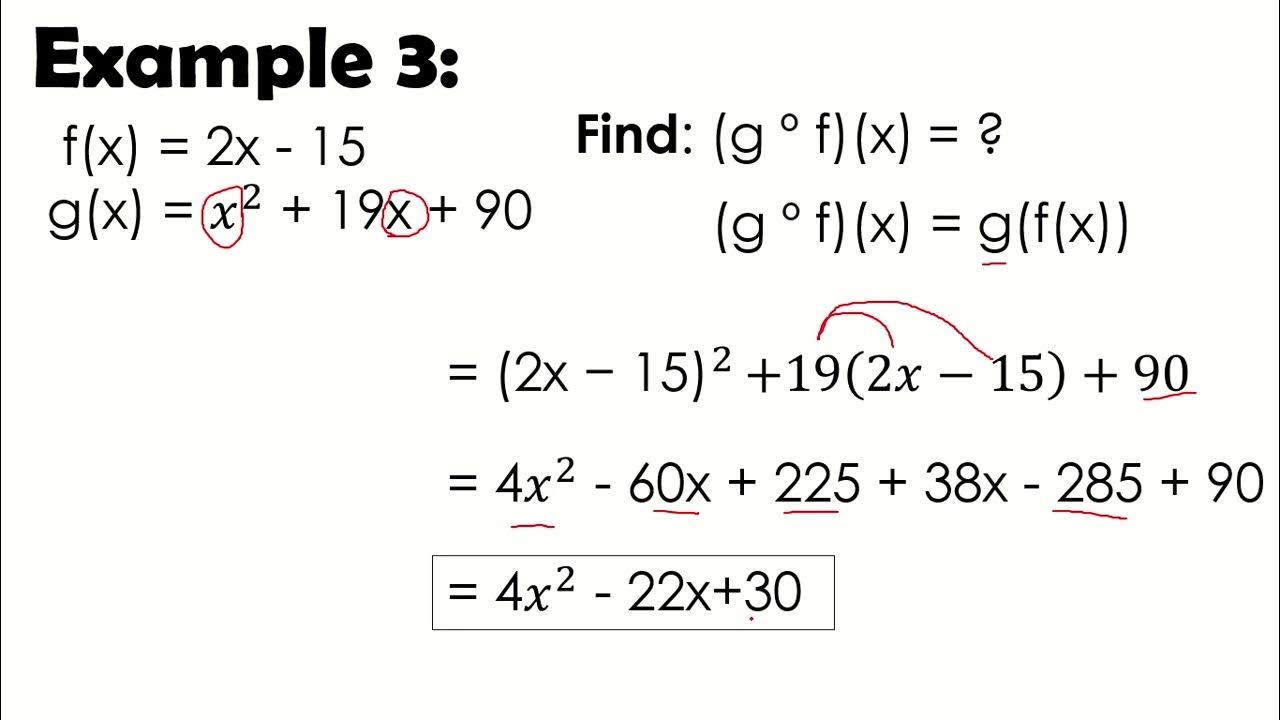FUNCTIONS: Composite Function and its Domain
Summary
TLDRThis video provides a comprehensive introduction to composite functions in mathematics, explaining their definition, composition, domain determination, and restrictions. It explores how two functions can be combined, with one function's output becoming the input of another. The video covers the process of finding composite functions, determining their domain, and ensuring their existence, especially when dealing with rational and root functions. Additionally, it explains how to restrict domains to make composite functions valid and offers several examples to illustrate these concepts.
Takeaways
- 😀 Composite functions are created by combining two functions where the output of one function becomes the input for the other.
- 😀 The domain of a composite function is determined by the domain of the second function and the range of the first function.
- 😀 When finding the domain of a composite function, be cautious of dividing by zero in rational functions or taking square roots of negative values in root functions.
- 😀 If a composite function exists, its domain is the same as the domain of the function whose output is used as input (i.e., the second function).
- 😀 In the example of composite functions, the output of function g becomes the input for function f, forming the composite function f of g.
- 😀 A composite function's domain can be restricted if the original domain does not naturally fit, ensuring that the composition remains valid.
- 😀 Graphs are useful for visualizing the domains, ranges, and the relationships between functions when determining the existence of a composite function.
- 😀 The existence of a composite function requires that the range of the first function is a subset of the domain of the second function.
- 😀 If the composite function doesn't exist naturally, you can restrict the domain of the first function to create a valid composite function.
- 😀 The process of finding the composite function involves substituting the output of one function into the other, simplifying, and analyzing the resulting domain and range.
- 😀 If the functions don't naturally form a composite, using restrictions like inequalities can help establish the necessary conditions for a valid composition.
Q & A
What is the definition of a composite function?
-A composite function is formed when two functions, f and g, are combined such that the output of the first function, g, becomes the input of the second function, f. The composite function is denoted as f(g(x)).
How can we visualize the composition of two functions using a taxi analogy?
-In the taxi analogy, function g picks up values from one area (represented by a green area), multiplies them by 2, and drops them off in a blue area. Function f then picks up those values from the blue area, adds 1 to them, and drops them off in a yellow area, forming a composite function.
How does the Venn diagram represent the composition of functions?
-The Venn diagram shows three sets: A, B, and C. The first function, g, maps an element x from set A to set B. The second function, f, then maps the result of g(x) from set B to set C. The composition of functions is represented as f(g(x)), mapping x from set A to set C.
What is the domain of a composite function?
-The domain of a composite function f(g(x)) is the same as the domain of the inner function g. When determining the domain, be cautious of functions with rational or root forms, where division by zero or square roots of negative values should be avoided.
In the example where f(g(x)) = 3 - x^2, what is the domain of the composite function?
-The domain of the composite function f(g(x)) = 3 - x^2 is the same as the domain of g, which is the interval from -1 to 1, inclusive, because g(x) is defined for values of x in this interval.
How do you find the domain of a composite function that involves a rational function?
-For a composite function involving a rational function, such as g(f(x)) = 2 / (x^2 - 1), ensure that the denominator is not zero. The domain is determined by excluding values that make the denominator equal to zero, which in this case are x = ±1.
What is the process for determining if two functions can be combined to form a composite function?
-To determine if two functions f and g can be combined, check if the range of the inner function g is a subset of the domain of the outer function f. If this condition holds, the composite function f(g(x)) exists.
How can we determine whether the composite function f(g(x)) exists for given functions f and g?
-To check if f(g(x)) exists, analyze the range of g and the domain of f. If the range of g is a subset of the domain of f, then the composite function f(g(x)) exists.
What happens if a composite function does not exist due to incompatible domains and ranges?
-If the composite function does not exist because the range of the inner function g is not a subset of the domain of f, the domain of g may need to be restricted. By restricting the domain, it is sometimes possible to make the composite function f(g(x)) valid.
How do you solve a quadratic inequality to restrict the domain of a function?
-To solve a quadratic inequality, first express it in interval form. Then, use methods like number lines to identify the values of x that satisfy the inequality. For example, for the inequality -x^2 + 10 ≥ 1, solving it results in the restricted domain of x in the interval from -3 to 3, inclusive.
Outlines

Esta sección está disponible solo para usuarios con suscripción. Por favor, mejora tu plan para acceder a esta parte.
Mejorar ahoraMindmap

Esta sección está disponible solo para usuarios con suscripción. Por favor, mejora tu plan para acceder a esta parte.
Mejorar ahoraKeywords

Esta sección está disponible solo para usuarios con suscripción. Por favor, mejora tu plan para acceder a esta parte.
Mejorar ahoraHighlights

Esta sección está disponible solo para usuarios con suscripción. Por favor, mejora tu plan para acceder a esta parte.
Mejorar ahoraTranscripts

Esta sección está disponible solo para usuarios con suscripción. Por favor, mejora tu plan para acceder a esta parte.
Mejorar ahora5.0 / 5 (0 votes)






